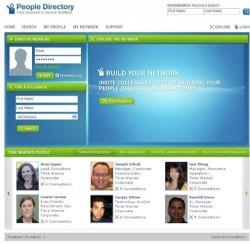 Time Warner may be suffering from slower online advertising, the decline of print, the AOL merger, and a slower economy, but next week, it will launch a new social-networking area for employees. It’s in beta now and may go live for employees on Wednesday.
Time Warner may be suffering from slower online advertising, the decline of print, the AOL merger, and a slower economy, but next week, it will launch a new social-networking area for employees. It’s in beta now and may go live for employees on Wednesday.
If you heard Starbucks’ presentation in 2007 about its ERE-Recruiting-Excellence-Award-winning intranet, you get a sense of what Time Warner has done.
Some of the key players include Lauren Levine, executive director of recruitment operations, and her boss Maggie Rubey Lynch; Pat Fili-Krushel, the EVP of administration; developers like Sanjay Uttam and Randy Gross; and the many divisional HR leaders at the company who put aside fears of an internal poachapalooza to support the project.
It has been about 5 1/2 years (long before we started telling the world each time we put on a new pair of socks) since Time Warner realized it had to do more to connect employees at such different divisions as HBO, Warner Brothers, and Time, Inc. “You only know who you know,” says Levine. “You really just do your own thing” unless you’re working on cross-company initiatives. Time Warner has an internal career site, but no common HRMS and no logical way to find out that Jane in Minneapolis doesn’t have to quit to work for Google because Susan in New York may have just the job for her.
The project started and stopped so much that the running joke, Levine says, became “will we ever do it?” Before the Facebook era, remember, we didn’t realize how willing people were to fill out information about themselves, let alone on multiple sites. Neither did Time Warner. But as LinkedIn grew in popularity, Levine says, “the idea of sharing information with the world wasn’t so scary anymore.”
The result was a partnership mainly between IT, Levine’s recruiting technology department, and communications. The group shifted its mindset over time from “here’s something for Time Warner” to “here’s something for Time Warner employees.”
“It’s their system, their site,” Levine says.
More LinkedIn and less Facebook, the intranet was built over the last year. Employees fill out information about their experience and interests, information that eventually may be able to “talk to” the Time Warner career site. If you list “creative,” for example, as one of your areas as expertise, eventually you may be able to receive new Time Warner job listings for “creative” types.
You can also sort and sift your network. Let’s say Levine’s doing a career fair at NYU and she wants to loop in some alumni from the school. She can sort the 172 people in her personal network by NYU graduates. Or, with the new intranet, she can sort by skills, such as “dot net,” and seek help from an internal employee on “dot net,” rather than going outside.
During the beta over the holidays, a couple hundred Time Warner employees received emails telling them about the site. Word spread. About 2,700 employees have logged in, more than 1,000 have added photos, and 16,000 connections have been made. Speaking of connections: one of the coolest parts of the site is a Flash virtual representation of who you’re connected to. If you click on one name, and then another, and so on — you’ll see a web of who you’re connected to. It’s like the Virtual Thesaurus, if you’ve ever seen how that site works.
“Rules of engagement,” Levine says, will help Time Warner managers from losing employees right when they need them. Employees don’t have to tell their managers they’re talking to another manager, but when serious consideration starts happening, the current manager is looped in. And at a high level, HR people will be involved to make sure that an SVP isn’t plucked out of their job in the middle of an assignment.
Despite rough times for the media industry, the company is still hiring, and “retention is a huge concern,” Levine says. “People who are still here when colleagues have left or have been laid off … there’s more work with less people. It’s a good time to focus on making sure employees know we’re progressive, we continue to focus on them, and from an internal mobility perspective we’re continuing to place them in new jobs.”